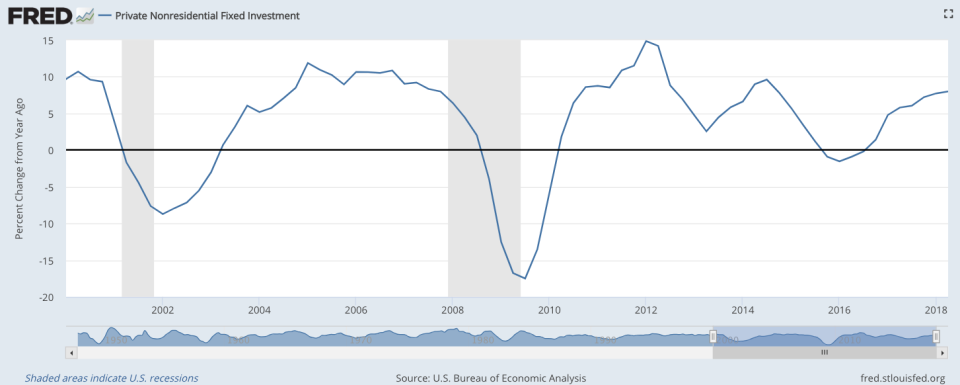The hole in the Trump economy
President Trump crowed about the latest GDP numbers, which showed the economy growing at a robust 4.1% pace in the second quarter. That’s more than double the pace of President Obama’s last year in office, an accomplishment any president would be happy to take credit for.
But economists are debating how much of that growth is real, and how much is illusory. And the answer could spell trouble for Trump right around the time he’s running for reelection in 2020.
Economist Bernard Baumohl of the Economic Outlook Group argues that temporary factors accounted for a considerable portion of the latest GDP numbers, and that without those effects, the economy would have grown just 2.5%, not 4.1%. Three temporary factors pumped up the latest numbers, Baumohl says: the Trump tax cuts, a surge in government spending, and a rush to ship some exports out of the country before new tariffs went into effect.
[Check out the Yahoo Finance Trumponomics Report Card]
The higher-than-usual export number in the second quarter means exports will be lower than usual in the third, which will cut into GDP growth. What’s less clear is whether the tax-cut and spending stimulus will be sustainable, or peter out. It’s possible that the stimulus contribution to GDP growth in 2018 and part of 2019 will be reversed by late 2019 and 2020, creating a drag on the economy. Some economists think a recession could even be in store by 2020.
The strong GDP number “immediately raises two questions,” writes Douglas Holtz-Eakin, president of the American Action Forum, a conservative think tank. “(1) Is this a one-time fluke or a sustainable trend? and (2) How much of the more rapid growth can be traced to changes in economic policy?”
While it’s too early to judge the full effect of the Trump tax cuts, which went into effect at the start of this year, Holtz-Eakin thinks the tax cuts and Trump’s deregulatory agenda are helping create sustainable growth. “The economy is strengthening,” he says. “Better economic policy is reinforcing this trend.”
Some things are clearly going right. Consumer spending is solid, and businesses are starting to spend more, perhaps on account of the tax cuts they’ve enjoyed this year. Here’s the trend for business spending, going back to 2000:

But business spending grew by more in 2011, 2012 and 2014, then fell back again. And businesses themselves may be wondering how solid economic growth really is. Mark Zandi, chief economist at Moody’s Analytics, argues that the tax cuts and spending hikes will account for about one-fourth of GDP growth this year and next. That bump will diminish and then disappear by 2020, he says. Recession could develop if Trump’s protectionist trade policies become too severe, or markets begin to react negatively to nearly $1 trillion in annual borrowing the Trump administration is now piling atop the $21 trillion national debt.
The debt’s the thing, says Baumohl. He points out that in the late 1990s, GDP growth and unemployment were near the same strong levels as they are now. But back then, the roaring economy was generating a tsunami of tax revenue that left the government with a budget surplus for four years in a row, from 1998 through 2001. That’s what’s supposed to happen when the economy is truly healthy.
Now, the federal deficit is getting bigger, not smaller. That suggests the boom is partly just borrowed money that will have to be paid back, like a credit-card splurge. “While the Trump administration may crow endlessly about how swell the economy performed last quarter, that 4.1% GDP print will quickly become a wistful memory,” Baumohl says. He predicts the economy will grow by just 2% in 2019. Even Obama did better.
Confidential tip line: [email protected]. Click here to get Rick’s stories by email.
Read more:
Rick Newman is the author of four books, including “Rebounders: How Winners Pivot from Setback to Success.” Follow him on Twitter: @rickjnewman
Follow Yahoo Finance on Facebook, Twitter, Instagram, and LinkedIn
